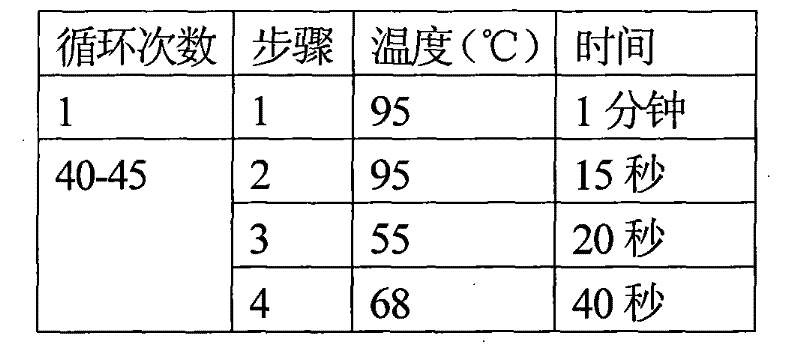Fluorescent quantitative PCR (Polymerase Chain Reaction) detection kit and detection method of HBV (Hepatitis B Virus) and TP (Treponema Pallidum) of donor corneas
A detection kit and fluorescence quantitative technology, applied in the determination/inspection of microorganisms, biochemical equipment and methods, fluorescence/phosphorescence, etc., can solve the problems of low sensitivity, PCR false positive pollution, false negative, etc., and achieve quantitative accuracy High, to avoid the effect of cross-contamination
- Summary
- Abstract
- Description
- Claims
- Application Information
AI Technical Summary
Problems solved by technology
Method used
Image
Examples
Embodiment 1
[0046] Example 1 Detection of HBV virus in donor cornea:
[0047] 1. Extraction of donor eyeball conjunctival tissue DNA and construction of positive working standards:
[0048] (1) Take 5 mg of the conjunctival tissue of the donor eyeball, put the tissue block into a centrifuge tube and chop it up, and add 180 μL of tissue lysis solution. Add 20 μL proteinase K, mix well, and incubate at 56°C until the tissue is completely lysed;
[0049] (2) Add 200 μL of purified lysate, mix with a vortex shaker for 15s, and incubate at 70°C for 10min. Add 200 μL of absolute ethanol to the sample, and mix with a vortex shaker for 15s;
[0050] (3) Transfer the sample from step 2 to the filter column, close the lid tightly and centrifuge at 8000 rpm for 1 min. Discard the waste liquid in the filter column, add 500 μL of eluent 1, and then centrifuge at 8000 rpm for 1 min;
[0051] (4) Discard the waste liquid in the filter column, add 500 μL of eluent 2, and centrifuge at 12000 rpm for 3...
Embodiment 2
[0066] Example 2 Donor corneal TP detection:
[0067] 1. Extraction of donor eyeball conjunctival tissue DNA and construction of positive working standard: The specific steps are the same as those of donor eyeball conjunctival tissue DNA extraction in Example 1.
[0068] A plasmid containing the TP gene (pUC57-TP) was constructed as a positive working standard. The positive working standard contains the target sequence amplified by the TP forward and reverse primers. In addition, an additional sequence is added on each side of the target sequence to make it closer to the structure of the actual test sample, so as to ensure the consistency with the actual test sample. Consistency of amplification efficiency.
[0069] Use Promega PureYield plasmid miniprep system kit to extract TP positive working standard plasmid, and then use UV spectrophotometer at 260nm and 280nm colorimetric to obtain the purity and concentration of TP positive working standard. According to copy number=(...
PUM
 Login to View More
Login to View More Abstract
Description
Claims
Application Information
 Login to View More
Login to View More - R&D
- Intellectual Property
- Life Sciences
- Materials
- Tech Scout
- Unparalleled Data Quality
- Higher Quality Content
- 60% Fewer Hallucinations
Browse by: Latest US Patents, China's latest patents, Technical Efficacy Thesaurus, Application Domain, Technology Topic, Popular Technical Reports.
© 2025 PatSnap. All rights reserved.Legal|Privacy policy|Modern Slavery Act Transparency Statement|Sitemap|About US| Contact US: help@patsnap.com

